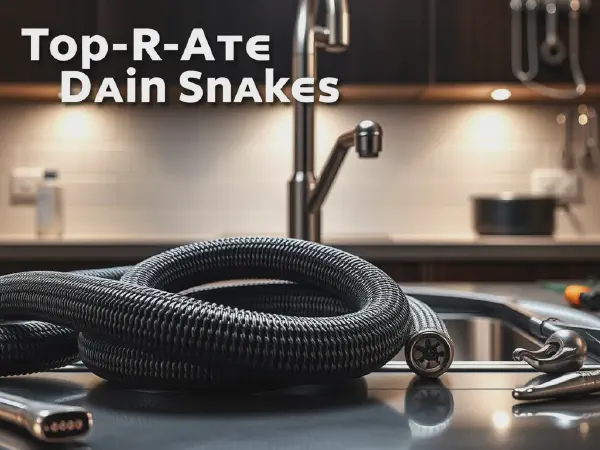Discover the Top-Rated Drain Snakes and Their Effectiveness

Comprehensive Guide to Drain Snakes: Everything You Need to Know
Drain snakes are essential tools for homeowners and plumbing professionals alike, designed to effectively clear clogged drains and maintain a smooth flow in plumbing systems. When faced with a slow or blocked drain, many people turn to drain snakes as a reliable solution. These tools are known for their flexibility and ability to navigate through various types of plumbing pipes, making them an essential addition to any toolbox.
A drain snake, often referred to as a plumbing snake or auger, comes in various sizes and types to accommodate different drainage scenarios. From minor clogs in kitchen sinks to more serious blockages in toilets and sewer lines, drain snakes provide a practical means of tackling such issues. Their evolution from manual to electric models has greatly enhanced their efficiency and ease of use, allowing users to choose the best one for their specific needs.
The operation of drain snakes revolves around their ability to penetrate and clear obstructions in plumbing systems. Using a helix-shaped coil or a rigid metal cable, these tools can break up stubborn clogs or retrieve debris that has settled in the pipes. The effectiveness of drain snakes can vary based on the type of snake used, the severity of the blockage, and the user's familiarity with the tool. With proper technique, drain snakes can save hours of costly plumbing service calls and restore functionality to your plumbing system.
The diversity of drain snakes means that there is an option for every plumbing issue. Whether you are dealing with hair buildup in a shower drain, grease stuck in a kitchen sink, or foreign objects lodged in a toilet, understanding the types of drain snakes available will empower you to tackle these challenges effectively. By familiarizing yourself with their various applications and operations, you will be better prepared to select the right drain snake when the need arises.
In this article, we will discuss the different types of drain snakes, how they work, tips for choosing the right one for your needs, maintenance guidelines, and valuable DIY plumbing tips when using these versatile tools. Understanding these aspects of drain snakes will not only enhance your plumbing knowledge but also equip you with the skills to manage common drain issues with confidence.
Types of Drain Snakes
There are primarily two types of drain snakes: manual drain snakes and electric drain snakes. Manual drain snakes, or hand-crank snakes, are lightweight and do not require power to operate. They are very effective for household clogs in sinks, tubs, and toilets, making them an excellent choice for DIY enthusiasts. The user simply feeds the snake into the drain and turns the crank to dislodge the blockage.
Electric drain snakes, on the other hand, offer a more powerful and automated solution for clearing stubborn clogs, especially in larger plumbing systems. These tools are equipped with an electric motor to rotate the cable, making them ideal for plumbing professionals or homeowners dealing with severe or recurring blockages. They often come with various attachments that can be used for specific types of clogs, offering versatility that manual snakes may not provide.
Another distinction in drain snakes comes from their design and intended use. Toilet augers, for example, are specialized drain snakes designed specifically for toilets, featuring a curved end that allows them to navigate the traps commonly found in toilet plumbing. Conversely, kitchen drain snakes are typically longer and more flexible, making them suitable for accessing deeper clogs in kitchen sinks. Knowing the difference between these types can save time and effort in resolving plumbing issues.
Moreover, drain snakes are also categorized as flexible or rigid. Flexible drain snakes are beneficial for navigating bends and curves in pipes, while rigid drain snakes are suited for more direct access to clogs. Choosing between these options largely depends on your plumbing system and the nature of the blockage you are dealing with.
How Drain Snakes Work
Understanding how drain snakes work is essential for their effective use. The basic mechanism behind drain snakes involves a rotating cable or coil that can reach into the pipes and physically break up or snag the material causing a blockage. As the snake is inserted into the drain, the user manually feeds it deeper until the resistance is felt, indicating that the blockage may be reached.
Once targeting the clog, turning the handle (for manual snakes) or activating the motor (for electric snakes) allows the coil to move and interact with the blockage, either breaking it apart or grabbing onto it so it can be pulled back out. This action is often effective in dislodging hair, grease, soap scum, and foreign objects that have caused the clog.
Comparative effectiveness varies between manual and electric drain snakes. Manual snakes can be highly effective for minor clogs but may struggle with more severe or complex blockages. On the other hand, electric drain snakes can handle more significant issues but require a degree of skill to operate safely and effectively.
Common problems that can be solved using drain snakes include slow drains, complete blockages in sinks and toilets, and recurring drain issues that result from build-ups over time. Regular use of drain snakes for maintenance can prevent these problems before they escalate into costly repairs or professional plumbing services.
Choosing the Right Drain Snake
Selecting the right drain snake for your needs involves considering several important factors. First, assess the type of plumbing issues you're likely to face. For minor home issues, a manual drain snake might suffice, while homes with older plumbing or frequent clogs might benefit from the efficiency of an electric snake.
Next, consider the size and type of the drain snake. The cable diameter is crucial; smaller cables (1/4 inch) are ideal for sinks and tubs, while larger cables (up to 3/4 inches) are necessary for toilets and larger pipes. Additionally, check the length of the snake; longer snakes can access deeper blockages, making them more versatile.
User reviews and recommendations can also provide insights into the performance and reliability of various drain snakes. Look for models with favorable ratings and testimonials that reflect ease of use and effectiveness. It’s often helpful to choose a product from a reputable brand known for plumbing tools.
Lastly, conduct a cost vs. effectiveness analysis. While manual drains are typically more affordable, electric drain snakes come at a higher price. Consider how often you anticipate needing a drain snake and whether the long-term savings of avoiding professional plumbers may justify the initial investment in a higher-cost electric model.
Maintenance of Drain Snakes
Proper maintenance of drain snakes is crucial to ensure they function well over time. Begin with proper cleaning techniques; after each use, thoroughly clean the snake to remove any debris or buildup that could lead to rust or corrosion. A simple wipe with a cloth and warm soapy water can do the trick for manual snakes, while electric snakes may require a specialized cleaner to ensure their durability.
It is also important to store your drain snake safely when not in use. Keeping it in a dry, clean area can prevent damage and prolong its lifespan. Many models come with a carrying case, which is ideal for maintaining their condition and making them easy to transport.
Regular maintenance tips include inspecting your drain snake periodically for any signs of wear or damage, such as fraying cables or bent coils. Addressing these issues early can prevent malfunction during use. Additionally, lubricating the cable regularly can help it move more freely, enhancing its effectiveness.
Watch for signs that your drain snake may need replacement, such as difficulty penetrating clogs or visible wear on the cable. Investing in a replacement before a significant issue arises can save both time and hassle in the long run.
DIY Plumbing with Drain Snakes
Using a drain snake for DIY plumbing can be empowering and save you money on plumbing services. To start, follow this step-by-step guide: First, gather your supplies: gloves, a bucket, and your chosen drain snake. Next, clear the area around the drain to have ample space to work. Insert the snake into the drain until you feel resistance, indicating you’ve reached the clog.
Then, turn the handle (manual snake) or activate the motor (electric snake) to break apart the clog. It may require several adjustments, so patience is key. Once you feel the blockage has loosened, slowly pull the snake back out while continuing to rotate. This will help retrieve any debris caught at the end of the snake, allowing for easier removal from the drain.
Common mistakes when using a drain snake include applying too much force, which can damage pipes, or not fully inserting the snake, leading to ineffective clog clearance. Take your time, and be gentle as you navigate bends in the plumbing system to prevent injury to the pipes.
Finally, know when to call a professional. If your attempts with a drain snake don’t yield results, or if you suspect the blockage may be due to more severe plumbing issues, scheduling a professional inspection is advisable to avoid worsening the problem. In summary, drain snakes are an invaluable tool for effective DIY plumbing solutions, but they should be used with care and consideration.
